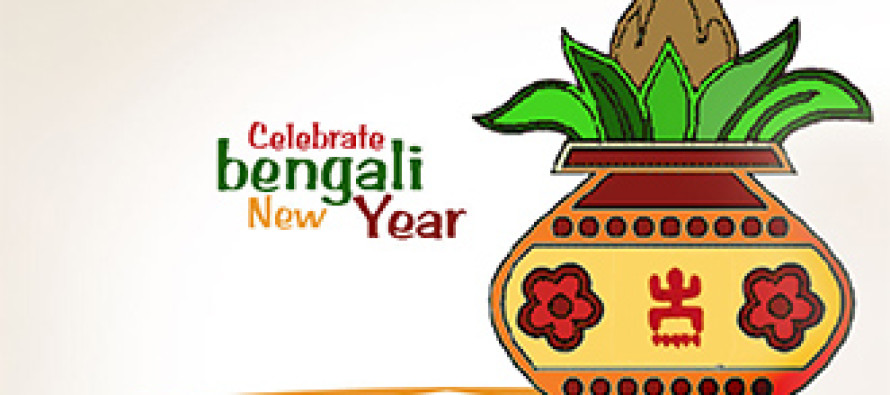Bengali New Year: Pahela Baishakh

The Bengali calendar consists of 6 seasons, instead of 4, with two months each, comprising: spring, summer, monsoon, autumn, early winter and winter. The first month Baishakh of Bengali year 1420 falls on 14th April, 2013. It is a public holiday.
This is the only festivity which is rooted in Bengali culture, while other festivities year round are based on religious and historical grounds. This day of Pahela Baishakh is enjoyed by poor and rich, countryside and urban areas. The farmers look to this day when their harvests are complete and they can relax and enjoy with their families.
Bengalis observe three calendars—Gregorian calendar for official and commercial transactions, Bengali Year for sowing and harvesting agricultural crops and Islamic calendar for Muslim festivities.
In diplomatic parlance, Bangladesh asserts that the country is a bridge between South Asia and South East Asia. This attribute is fully reflected by the fact that Bangladesh observes the Bengali New Year together with Myanmar, Thailand, Cambodia and Laos .
In South East Asian the New Year is celebrated with water festival. People pour water over one another and pouring water signifies cleansing the body and mind of the evils of the past year.
Ordinarily the houses are cleaned or even painted and new dress is worn and there is an air of festive mood among people in all these countries. People take early bath and put in their best dresses.
Music, dance and colourful procession are on the public places. Music and dance are displayed at decorated pavilions and hundreds of thousands of people celebrate the New Year.
Usually on the day of the New Year in Bangladesh, one greets or telephones or sends card to another with the words “Shuva Nababarsha” ( Happy New Year).
On the day, people gather in the morning to have a look at the sunrise. Songs ushering the New Year are performed by the singers. Artists present songs to usher in the new year
with Tagore song ,
“Come, O Baishakh, Come upon us
With your ascetic breath, dust away that which is dying,
Be gone the refuses and remnants of the past
Let go old memories, let go forgotten melodies,
Let teardrops vaporise and fade into distant skies,
Wipe away weariness, eradicate infirmity,
Bathed in fire, may the earth gain purity”.
Bengalis can be seen in their tradition attire. While the young ladies wear saris, the boys put on Kurta Pyajama. There is also an age-old tradition of starting the day by having a breakfast consisting of panta bhat (soaked rice) along with onion, green chillies, and fried Hilsa fish.
In several parts of the state Boishakhi fairs are organized and different agricultural products, toys, cosmetics, traditional handicrafts, different food items and sweets are sold at the Boishakhi fairs.
The fairs are also a source of entertainment for the people various kinds of cultural programs taking place such as dancing, singing, drama, jatra, pala gan, jarigan, gambhira gan, kobigan, gazir gan and alkap gan.
Folk songs, baul, murshidi, marfati and bhatiali songs are also performed by artists. Narrative plays such as Yusuf-Zulekha, Laila-Majnu are also staged on this festive occasion. Nabo Barsho poems are recited as a part of the Bengali New Year celebrations. Merry-go-rounds and puppet shows are among the other popular attractions of these fairs.
In Dhaka.numerous people assemble early in the morning at Ramna Park where the Chhayanat artists give a beautiful start to the day with Rabindranath Tagore’s songs.
The historical significance of the Bengali New Year in Bangladesh dates back to the year 1965 when the day was observed by the Chhayanat. The then Government of Pakistan tried to suppress the Bengali culture by putting a ban on Rabindranath Tagore’s poems and songs.
The Chhayanat however, protested against this move by opening up their Bengali New Year celebrations at Ramna Park with nothing but the same songs and poems by Tagore. In East Pakistan, this day continued to be observed as a symbol of Bengali culture. Following the year 1972, this came to be observed as a national festival.
Ceremonies welcoming the ‘Nabo Borsho’ also take place at the Institute of Fine Arts, University of Dhaka. Parades and colorful processions are organized by the students and the teachers, at the campus. Different types of cultural and social programs are organized throughout the day, which are also broadcasted on radio and television.
For the Bengalis, the significance of the Bengali New Year is surely great. This is the day when people pray for the well being and prosperity of their dear ones.
On this day, people are required to clear off all the dues and loans. The Bengali New Year or Nabo Borsho is the day to buy and prepare new account books by the Bengali businessmen. It is known as Haalkhata.
The day is a cultural, social and literary feast for more than 300 million of Bengali language- speaking people whether they live in the country of Bangladesh, West Bengal, Tripura and other states in India or overseas..
Interestingly, the Bengali New Year is a creation of the Mughals. Under the Mughals, agricultural taxes were collected according to the Hijri calendar. However, as the Hijri calendar is a purely lunar calendar, it does not coincide with the harvest. As a result, farmers were hard-pressed to pay taxes out of season. In order to streamline tax collection, the Mughal Emperor Akbar ordered a reform of the calendar.
Accordingly, Fatehullah Shirazi, a renowned scholar and astronomer, formulated the Bengali year on the basis of the Hijri lunar and Hindu solar calendars. The new year (agricultural year) was introduced on 10/11 March 1584, but was dated from Akbar’s ascension to the throne in 1556. The New Year subsequently became known as the Bengali year.
By Barrister Harun ur Rashid
Former Bangladesh Ambassador to the UN, Geneva.


